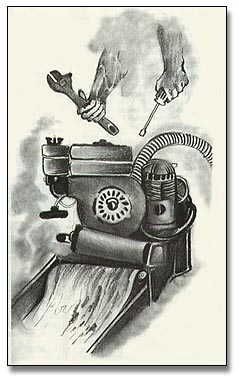

by George McConnell
What can go wrong will!! And does!!
Never has such an adage been more true than with small engines – on a prospecting trip – a BILLION miles from nowhere! The engine sits after your arm breaks from trying to start it, and tempers flare while someone screams “The thing worked last year!”
Here are a few tips:
Repair of anything in the field is much more difficult, not to mention the trips to town for a spark plug wrench, or a clamp, only to find the store just closed! Make up a small kit of tools and parts to keep with the mining equipment.
wrench, or a clamp, only to find the store just closed! Make up a small kit of tools and parts to keep with the mining equipment.
1. Pliers
2. 4-way screwdriver
3. Inexpensive socket set with spark plug socket that will fit your spark plug!
4. Allen wrenches
5. Extra engine oil
6. Extra pump seal kit and gaskets and clamps
7. Extra spark plug
8. Whatever else you can think of that you’ll need!
Ok-ok, the season is over and I’m dreaming of next year’s expedition. DON’T WAIT. Now is the time to pickle that engine!
How to “Pickle”:
1. Make it a habit to run the engine until it runs out of fuel. This helps stop problems from “modern” gas formulas, forming gum and goo in the carburetor.
2. Check the fuel filter and replace it if you’re not sure.
3. Disconnect the spark plug wire and “ground” it to the engine. Most small engines have a triangular “tab” for slipping the spark plug wire onto it.
4. Change the engine oil (dispose of the old oil properly). If you don’t remember when you changed it last, or just “checked” it, change it NOW.
5. Remove spark plug. If it looks oily, cracked, black, or just plain crummy, REPLACE it. If it’s ok, check the spark plug GAP – .020-.025 is typical. If you’re not sure, get a new plug and make sure it’s the right plug for your engine.
6. “Pickling” rings and valve, and cylinder walls, protection hint: Pour a TEASPOON of “Marvel Mystery” oil (any light oil will do) into the spark plug hole. (Don’t go crazy and overdo it.) Let it sit for a minute, then press your thumb over the spark plug hole (after making sure the spark plug wire is grounded to the frame. Caution: “Instant Shock Therapy” is very possible if it is not.) SLOWLY pull the starter cord, ONE TIME ONLY! You will feel a suction and then a pressure “poof” on your thumb. (If you don’t, it’s time for the repair shop engine doctor!) The oil is now distributed into the cylinder rings and other engine parts to keep them from freezing up and happy while in storage.
7. Make sure weeds and twigs are not hanging in or on the fan.
8. Clean the air cleaner (foam type) and replace if needed.
a) For the foam type, wash in light soapy water, squeeze and let dry. Oil it up, squeeze out the excess oil and re-install.
b) For the paper type, blow carefully on the inside of the filter with an air hose. If it’s too clogged, replace it.
9. Re-install spark plug and wire.
10. Wipe the entire engine down removing dust, dirt and goo. You paid a lot of money for it, take pride in it by keeping it clean.
11. Don’t “adjust” those little screws by the carburetor, unless you’re SURE of what you’re doing. Those “adjustment” screws normally don’t “un-adjust” themselves. Consult the engine manual for adjustments and tweaking for altitude load or for poor fuel, only after everything else checks out, (clean air filter, etc…)
Hint: After dredging, high banking, etc…, I cover the engine, after it cools, with a plastic garbage bag in case it rains! That way, it will start easily the next time.
Now you can get back to dreaming and planning your next expedition with reasonable confidence that y our engine will run when you get there.
See you on the river!





